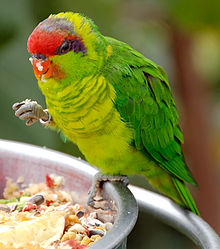Iris lorikeet
| Iris lorikeet | |
|---|---|

| |
| At San Diego Zoo | |
| Scientific classification | |
| Domain: | Eukaryota |
| Kingdom: | Animalia |
| Phylum: | Chordata |
| Class: | Aves |
| Order: | Psittaciformes |
| Family: | Psittaculidae |
| Genus: | Saudareos |
| Species: | S. iris
|
| Binomial name | |
| Saudareos iris (Temminck, 1835)
| |
| Synonyms | |
|
Psitteuteles iris | |
The iris lorikeet (Saudareos iris) is a small, up to 20 cm (8 in) long, green lorikeet bird. The male has a red forehead, yellow nape, purple band back from eye between nape and cheek, and yellowish below. The female almost similar with red-marked green forecrown and yellowish green cheek.
The iris lorikeet is distributed in the forests and woodlands on the islands of Wetar and Timor in the Lesser Sundas. It is found from sea level to altitude of 1,500 m (5,000 ft). The iris lorikeet is usually found in small flocks.
Due to ongoing habitat loss, limited range and illegal trapping for the caged-bird trade, the iris lorikeet is evaluated as Near Threatened on IUCN Red List of Threatened Species. It is listed on Appendix II of CITES.
Taxonomy[edit]
The iris lorikeet was formerly placed in the genus Psitteuteles but was moved to a newly introduced genus Saudareos based on the results of a molecular genetic analysis of the lorikeets published in 2020.[2][3] There are two or three poorly differentiated subspecies:[4][5]
- S. i iris (West Timor) -
- S. i. wetterensis (Wetar) – larger area of darker green on side of head.
- S. i. rubripileum (East Timor) – hindcrown also red, violet-blue band on hindneck.
Description[edit]
The iris lorikeet is 20 cm (8 in) long. It is mostly green with pale-green transverse striations on its underside. The head is red above the eye and there is a purple band from the eyes extending over the ears. The beak is red-orange, the iris is orange, and the legs are bluish-grey. The male and female are almost identical, but the red on the head of the female is paler and less extensive. Juveniles resemble females, but have a brownish bill, brown irises, duller purple bands and less red on the head. The extent and shade of the red and purple on the head varies between two or three subspecies.[5]
References[edit]
- ^ BirdLife International (2016). "Psitteuteles iris". IUCN Red List of Threatened Species. 2016: e.T22684573A93035973. doi:10.2305/IUCN.UK.2016-3.RLTS.T22684573A93035973.en. Retrieved 10 February 2024.
- ^ Joseph, L.; Merwin, J.; Smith, B.T. (2020). "Improved systematics of lorikeets reflects their evolutionary history and frames conservation priorities". Emu – Austral Ornithology. 120 (3): 201–215. doi:10.1080/01584197.2020.1779596.
- ^ Gill, Frank; Donsker, David; Rasmussen, Pamela, eds. (2024). "Parrots, cockatoos". IOC World Bird List. 14.1. International Ornithologists' Union. Retrieved 10 February 2024.
- ^ "Zoological Nomenclature Resource: Psittaciformes". 9.004. zoonomen.net. 2 October 2009.
- ^ a b Forshaw (2006). plate 14.
Cited texts[edit]
- Forshaw, Joseph M. (2006). Parrots of the World; an Identification Guide. Illustrated by Frank Knight. Princeton University Press. ISBN 0-691-09251-6.
External links[edit]
- BirdLife Species Factsheet
- Oriental Bird Images: Iris Lorikeet Selected photos

